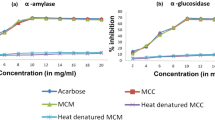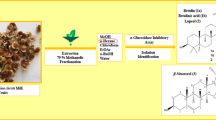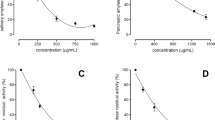Abstract
Inhibition of α-glucosidase and pancreatic α-amylase is one of the therapeutic approaches for delaying carbohydrate digestion, resulting in reduced postprandial glucose. The aim of this study was to evaluate the phytochemical analysis and the inhibitory effect of various cinnamon bark species against intestinal α-glucosidase and pancreatic α-amylase. The results showed that the content of total phenolic, flavonoid, and condensed tannin ranged from 0.17 to 0.21 g gallic acid equivalent/g extract, from 48.85 to 65.52 mg quercetin equivalent/g extract, and from 0.12 to 0.15 g catechin equivalent/g extract, respectively. The HPLC fingerprints of each cinnamon species were established. Among cinnamon species, Thai cinnamon extract was the most potent inhibitor against the intestinal maltase with the IC50 values of 0.58 ± 0.01 mg/ml. The findings also showed that Ceylon cinnamon was the most effective intestinal sucrase and pancreatic α-amylase inhibitor with the IC50 values of 0.42 ± 0.02 and 1.23 ± 0.02 mg/ml, respectively. In addition, cinnamon extracts produced additive inhibition against intestinal α-glucosidase and pancreatic α-amylase when combined with acarbose. These results suggest that cinnamon bark extracts may be potentially useful for the control of postprandial glucose in diabetic patients through inhibition of intestinal α-glucosidase and pancreatic α-amylase.



Similar content being viewed by others
References
Tappy L, Lê KA (2010) Metabolic effects of fructose and the worldwide increase in obesity. Physiol Rev 90:23–46
Nahas R, Moher M (2009) Complementary and alternative medicine for the treatment of type 2 diabetes. Can Fam Physician 55:591–596
Lee SH, Park MH, Heo SJ, Kang SM, Ko SC, Han JS, Jeon YJ (2010) Dieckol isolated from Ecklonia cava inhibits alpha-glucosidase and alpha-amylase in vitro and alleviates postprandial hyperglycemia in streptozotocin-induced diabetic mice. Food Chem Toxicol 48:2633–2637
Akkarachiyasit S, Charoenlertkul P, Yibchok-Anun S, Adisakwattana S (2010) Inhibitory activities of cyanidin and its glycosides and synergistic effect with acarbose against intestinal α-glucosidase and pancreatic α -amylase. Int J Mol Sci 11:3387–3396
Baron AD (1998) Postprandial hyperglycaemia and alpha-glucosidase inhibitors. Diabetes Res Clin Pract 40(Suppl):S51–S55
Srinivasan K (2005) Role of species beyond food flavoring: Nutraceuticals with multiple health effects. Food Rev Int 21:167–188
Barceloux DG (2009) Cinnamon (Cinnamomum species). Dis Mon 55:327–335
Dugoua JJ, Seely D, Perri D, Cooley K, Forelli T, Mills E, Koren G (2007) From type 2 diabetes to antioxidant activity: A systematic review of the safety and efficacy of common and cassia cinnamon bark. Can J Physiol Pharmacol 85:837–847
Crawford P (2009) Effectiveness of cinnamon for lowering hemoglobin A1C in patients with type 2 diabetes: A randomized, controlled trial. J Am Board Fam Med 22:507–512
Otto AD (2010) Cinnamon as a supplemental treatment for impaired glucose tolerance and type 2 diabetes. Curr Diab Rep 10:170–172
Ping H, Zhang G, Ren G (2010) Antidiabetic effects of cinnamon oil in diabetic KK-Ay mice. Food Chem Toxicol 48:2344–2349
Jarvill-Taylor KJ, Anderson RA, Graves DJ (2001) A hydroxychalcone derived from cinnamon functions as a mimetic for insulin in 3 T3-L1 adipocytes. J Am Coll Nutr 20:327–236
Peng X, Cheng KW, Ma J, Chen B, Ho CT, Lo C, Chen F, Wang M (2008) Cinnamon bark proanthocyanidins as reactive carbonyl scavengers to prevent the formation of advanced glycation endproducts. J Agric Food Chem 56:1907–1911
Sheng X, Zhang Y, Gong Z, Huang C, Zang YQ (2008) Improved insulin resistance and lipid metabolism by cinnamon extract through activation of peroxisome proliferator-activated receptors. PPAR Res 2008:581348
Verspohl EJ, Bauer K, Neddermann E (2005) Antidiabetic effect of Cinnamomum cassia and Cinnamomum zeylanicum in vivo and in vitro. Phytother Res 19:203–206
Okada Y, Okada M, Sagesaka Y (2010) Screening of dried plant seed extracts for adiponectin production activity and tumor necrosis factor-alpha inhibitory activity on 3 T3-L1 adipocytes. Plant Foods Hum Nutr 65:225–232
Toda S (2005) Antioxidative effects of polyphenols in leaves of Houttuynia cordata on protein fragmentation by copper-hydrogen peroxide in vitro. J Med Food 8:266–268
Adisakwattana S, Chantarasinlapin P, Thammarat H, Yibchok-Anun S (2009) A series of cinnamic acid derivatives and their inhibitory activity on intestinal alpha-glucosidase. J Enzyme Inhib Med Chem 24:1194–1200
Adisakwattana S, Jiphimai P, Prutanopajai P, Chanathong B, Sapwarobol S, Ariyapitipan T (2010) Evaluation of alpha-glucosidase, alpha-amylase and protein glycation inhibitory activities of edible plants. Int J Food Sci Nutr 61:295–305
Mulimani VH, Supriya D (1993) Effect of heat treatments on alpha-amylase inhibitor activity in sorghum (Sorghum bicolour L.). Plant Foods Hum Nutr 44:181–186
Tundis R, Loizzo MR, Menichini F (2010) Natural products as alpha-amylase and alpha-glucosidase inhibitors and their hypoglycaemic potential in the treatment of diabetes: An update. Mini Rev Med Chem 10:315–331
Akilen R, Tsiami A, Devendra D, Robinson N (2010) Glycated haemoglobin and blood pressure-lowering effect of cinnamon in multi-ethnic Type 2 diabetic patients in the UK: A2 randomized, placebo-controlled, double-blind clinical trial. Diabet Med 27:1159–1167
Crawford P (2009) Effectiveness of cinnamon for lowering hemoglobin A1C in patients with type 2 diabetes: A randomized, controlled trial. J Am Board Fam Med 22:507–512
Abdul-Ghani MA, DeFronzo RA (2009) Plasma glucose concentration and prediction of future risk of type 2 diabetes. Diabetes Care 32(Suppl 2):S194–S198
Mai TT, Thu NN, Tien PG, Van Chuyen N (2007) Alpha-glucosidase inhibitory and antioxidant activities of Vietnamese edible plants and their relationships with polyphenol contents. J Nutr Sci Vitaminol (Tokyo) 53:267–276
Lee YA, Cho EJ, Tanaka T, Yokozawa T (2007) Inhibitory activities of proanthocyanidins from persimmon against oxidative stress and digestive enzymes related to diabetes. J Nutr Sci Vitaminol (Tokyo) 53:287–292
Chiasson JL, Josse RG, Gomis R, Hanefeld M, Karasik A, Laakso M (2003) Acarbose treatment and the risk of cardiovascular disease and hypertension in patients with impaired glucose tolerance: The STOP-NIDDM trial. JAMA 290:486–494
Yamasaki Y, Katakami N, Hayaishi-Okano R, Matsuhisa M, Kajimoto Y, Kosugi K, Hatano M, Hori M (2005) Alpha-glucosidase inhibitor reduces the progression of carotid intima-media thickness. Diabetes Res Clin Pract 67:204–210
Hanefeld M, Fischer S, Schulze J, Spengler M, Wargenau M, Schollberg K, Fücker K (1991) Therapeutic potentials of acarbose as first-line drug in NIDDM insufficiently treated with diet alone. Diabetes Care 14:732–737
Acknowledgement
This research was financially supported by Faculty of Allied Health Sciences, Chulalongkorn University and Research Projects for Undergraduate Students (RPUS) by The Thailand Research Fund (TRF). The author gratefully acknowledges The Medical Food Research and Development Center and Research Group of Herbal Medicine for Prevention and Therapeutic of Metabolic diseases which have been financially and institutionally supported by Chulalongkorn University.
Author information
Authors and Affiliations
Corresponding author
Rights and permissions
About this article
Cite this article
Adisakwattana, S., Lerdsuwankij, O., Poputtachai, U. et al. Inhibitory Activity of Cinnamon Bark Species and their Combination Effect with Acarbose against Intestinal α-glucosidase and Pancreatic α-amylase. Plant Foods Hum Nutr 66, 143–148 (2011). https://doi.org/10.1007/s11130-011-0226-4
Published:
Issue Date:
DOI: https://doi.org/10.1007/s11130-011-0226-4




